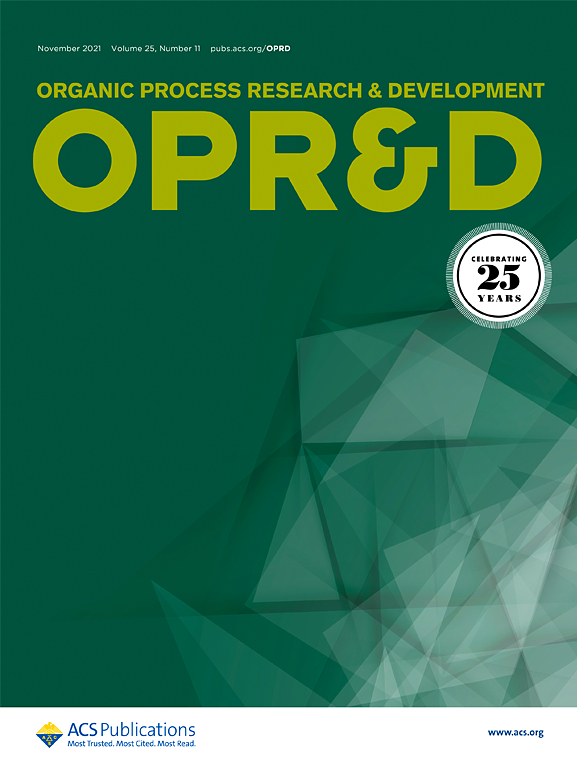基于数据驱动模型的有效药物成分结晶化研究
IF 3.1
3区 化学
Q2 CHEMISTRY, APPLIED
引用次数: 0
摘要
广泛的研究工作致力于研究和理解活性药物成分(API)的结晶动力学,旨在优化产品质量,收率和稳健性。在这项研究中,我们开发、调整并演示了一个数据丰富的实验工作流程,可用于表征和模拟API的抗溶剂结晶的动态行为。首先,采用自动化、平行实验技术和经验模型来描述原料药溶解度作为温度和溶剂组成的函数。接下来,利用实验室自动化和过程分析技术的高效协议,使用原位傅里叶变换红外光谱生成准确的化学计量模型来量化API上清浓度。通过22全因子设计和数据丰富的实验,获得了上清液浓度曲线,以表征结晶温度和反溶剂电荷速率对分离过程的影响。这些多变量、时间序列数据轮廓随后使用动态响应面方法(DRSM)建模。这种方法提供了对结晶过程操作参数敏感性的全面理解,以实现快速的工艺开发。DRSM模型成功地预测了基于抗溶剂分数、添加速率和温度的浓度动态,并对实验初始设计的训练数据集进行了单独的验证实验。这项研究强调了如何将数据丰富的实验和过程建模相结合,从而为制药生产中的结晶优化和控制策略提供有价值的过程知识。本文章由计算机程序翻译,如有差异,请以英文原文为准。

Data-Driven Modeling for the Enhanced Understanding for the Crystallization of an Active Pharmaceutical Ingredient
Extensive research efforts are dedicated to studying and understanding the dynamics of the crystallization of an active pharmaceutical ingredient (API), aiming to optimize product quality, yield, and robustness. In this study, we developed, tuned, and demonstrated a data-rich experimentation workflow that can be used to characterize and model the dynamic behavior of an antisolvent crystallization of an API. First, automated, parallel experiment technology and empirical models are used to describe the API solubility as a function of temperature and solvent composition. Next, an efficient protocol that leverages laboratory automation and process analytical technologies was used to generate an accurate chemometric model to quantify API supernatant concentration with in situ Fourier-transformed infrared spectroscopy. Using a 22 full-factorial design and data-rich experimentation, supernatant concentration profiles were obtained to characterize the impact of the crystallization temperature and antisolvent charge rate on the isolation procedure. These multivariate, time-series data profiles were subsequently modeled using dynamic response surface methodology (DRSM). This approach provided a comprehensive understanding of the sensitivity of the operating parameters on the crystallization process to enable rapid process development. The DRSM model successfully predicted the concentration dynamics based on antisolvent fraction, addition rate, and temperature for the training data set from the initial design of the experiment as well as a separate validation experiment. This study highlights how the combination of data-rich experimentation and process modeling can lead to valuable process knowledge for optimization and control strategies for crystallization in pharmaceutical manufacturing.
求助全文
通过发布文献求助,成功后即可免费获取论文全文。
去求助
来源期刊
CiteScore
6.90
自引率
14.70%
发文量
251
审稿时长
2 months
期刊介绍:
The journal Organic Process Research & Development serves as a communication tool between industrial chemists and chemists working in universities and research institutes. As such, it reports original work from the broad field of industrial process chemistry but also presents academic results that are relevant, or potentially relevant, to industrial applications. Process chemistry is the science that enables the safe, environmentally benign and ultimately economical manufacturing of organic compounds that are required in larger amounts to help address the needs of society. Consequently, the Journal encompasses every aspect of organic chemistry, including all aspects of catalysis, synthetic methodology development and synthetic strategy exploration, but also includes aspects from analytical and solid-state chemistry and chemical engineering, such as work-up tools,process safety, or flow-chemistry. The goal of development and optimization of chemical reactions and processes is their transfer to a larger scale; original work describing such studies and the actual implementation on scale is highly relevant to the journal. However, studies on new developments from either industry, research institutes or academia that have not yet been demonstrated on scale, but where an industrial utility can be expected and where the study has addressed important prerequisites for a scale-up and has given confidence into the reliability and practicality of the chemistry, also serve the mission of OPR&D as a communication tool between the different contributors to the field.

 求助内容:
求助内容: 应助结果提醒方式:
应助结果提醒方式:


